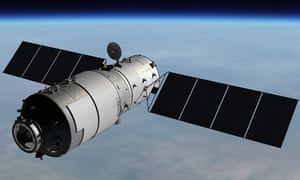China's Tiangong-1 space station will crash to Earth within weeks
Experts say it is impossible to plot where module will re-enter the atmosphere, but the chance is higher in parts of Europe, US, Australia and New Zealand
China’s first space station is expected to come crashing down to Earth within weeks, but scientists have not been able to predict where the 8.5-tonne module will hit.
The US-funded Aerospace Corporation estimates Tiangong-1 will re-enter the atmosphere during the first week of April, give or take a week. The European Space Agency says the module will come down between 24 March and 19 April.
In 2016 China admitted it had lost control of Tiangong-1 and would be unable to perform a controlled re-entry.
The statement from Aerospace said there was “a chance that a small amount of debris” from the module will survive re-entry and hit the Earth.
“If this should happen, any surviving debris would fall within a region that is a few hundred kilometres in size,” said Aerospace, a research organisation that advises government and private enterprise on space flight.
Aerospace warned that the space station might be carrying a highly toxic and corrosive fuel called hydrazine on board.
The report includes a map showing the module is expected to re-enter somewhere between 43° north and 43° south latitudes. The chances of re-entry are slightly higher in northern China, the Middle East, central Italy, northern Spain and the northern states of the US, New Zealand, Tasmania, parts of South America and southern Africa.
However, Aerospace insisted the chance of debris hitting anyone living in these nations was tiny. “When considering the worst-case location … the probability that a specific person (ie, you) will be struck by Tiangong-1 debris is about one million times smaller than the odds of winning the Powerball jackpot.
“In the history of spaceflight no known person has ever been harmed by reentering space debris. Only one person has ever been recorded as being hit by a piece of space debris and, fortunately, she was not injured.”
Jonathan McDowell, an astrophysicist from Harvard University and space industry enthusiast, also sounded a note of caution. He said fragments from a similar-sized rocket re-entered the atmosphere and landed in Peru in January. “Every couple of years something like this happens, but Tiangong-1 is big and dense so we need to keep an eye on it,” he told the Guardian.
McDowell said Tiangong-1’s descent had been speeding up in recent months and it was now falling by about 6km a week, compared with 1.5km in October. It was difficult to predict when the module might land because its speed was affected by the constantly changing “weather” in space, he said.
“It is only in the final week or so that we are going to be able to start speaking about it with more confidence,” he said.
“I would guess that a few pieces will survive re-entry. But we will only know where they are going to land after after the fact.”
The Tiangong-1 or Heavenly Palace lab was launched in 2011 and described as a “potent political symbol” of China – part of a scientific push to become a space superpower.
It was used for both manned and unmanned missions and visited by China’s first female astronaut, Liu Yang, in 2012.
In 1991 the Soviet Union’s 20-tonne Salyut 7 space station crashed to Earth while still docked to another 20-tonne spacecraft called Cosmos 1686. They broke up over Argentina, scattering debris over the town of Capitán Bermúdez.
Nasa’s 77-tonne Skylab space station came hurtling to Earth in an almost completely uncontrolled descent in 1979, with some large pieces landing outside Perth in Western Australia.


No comments:
Post a Comment
Comments always welcome!